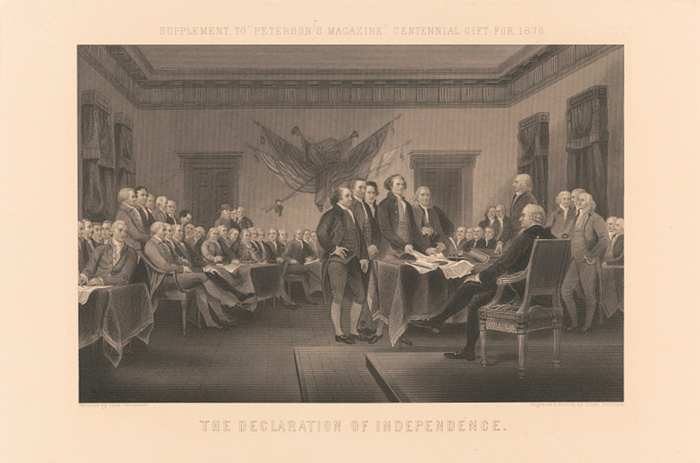Teach This Poem is a weekly series featuring a poem from our online poetry collection, accompanied by interdisciplinary resources and activities designed to help K-12 teachers quickly and easily bring poetry into the classroom.

The following activities and questions are designed to help your students use their noticing skills to move through the poem and develop their thinking about its meaning with confidence, using what they’ve noticed as evidence for their interpretations. Read more about the framework upon which these activities are based.
- Warm-up (give every student a Post-It and hang a poster at the front of the room that reads “Freedom Means”):On your Post-It note, write down what freedom means to you by using the hashtag #freedommeans. When you finish, add your Post-It to the poster. (Enlist volunteers to read aloud student responses.)
- Before Reading the Poem (noticing and pair share): Look carefully at the engraving of the painting “The Declaration of Independence” by John Trumball. With your partner or tablemates, discuss what is happening in this image. Look again. What else do you notice? What is going on in the room? Who is in the room? Who is absent from the room?
- Reading the Poem: Read the poem “Declaration” by Tracy K. Smith silently. Notice the words and phrases that jump out at you, then think about what you noticed as you annotate the poem.
- Listening to the Poem (enlist two volunteers to read the poem aloud): Listen as the poem is read aloud twice, and write down any additional words and phrases that jump out at you. Call back the lines that you like by saying these lines aloud with your group.
- Small-group Discussion: Share what you noticed in the poem with your partner and another pair of students. Based on the details you just shared, what connections can you make between the poem and the image? In what ways are they similar? Different?
- Whole-class Discussion: (Teachers, share with students that this poem is an erasure, which is a form of poetry where poets choose to “erase” or delete many of the lines from a text, thus creating a new piece of writing.) How does it affect your reading to know that this poem is an erasure of the Declaration of Independence? Who is the “He” in the poem and what is his role? Who do you think is speaking in this poem, and how does this relate to the engraving? What is purposefully missing from the poem?
- Extension for Grades 7-8: Using this version of the Declaration of Independence, try your hand at erasing words to create new meaning by shading with pencil words that you wish to remove. (Teachers, you may want to model this with a line from the text, to show students how to erase.) Or, choose the ten words or phrases in the Declaration of Independence that stand out to you most, and write a persuasive essay explaining their significance.
- Extension for Grades 9-12: With a partner, take turns looking closely at Thomas Jefferson’s original Declaration and the suggested edits. Discuss how each of these edits could have changed the course of American history. Now, with your partner, write your own version of the first two paragraphs. Next, write a paragraph explaining your decisions.
More Context for Teachers: When she was appointed the twenty-second U.S. poet laureate, Tracy K. Smith spoke to the Academy of American Poets about the role of the poet in American culture. She said, “I see the poet as someone who has made a commitment not just to self-expression, but to an active and an eager listening to the world and the voices outside of the self. The poet is willing to be changed by the things that language can reveal—about who we are, how we live, what our impact upon the world and one another is.” Read more.
